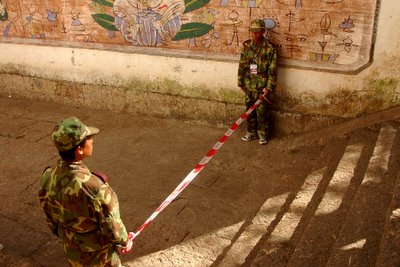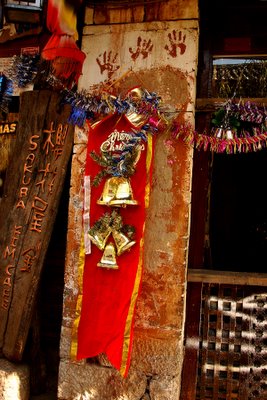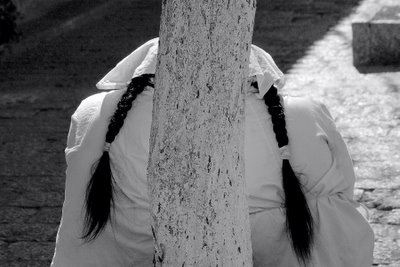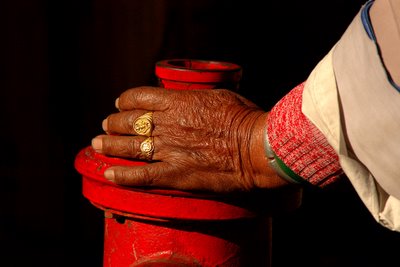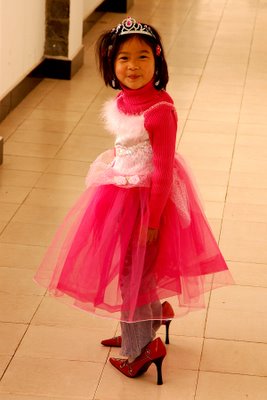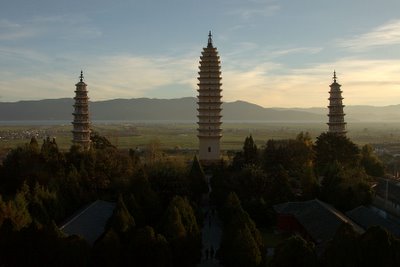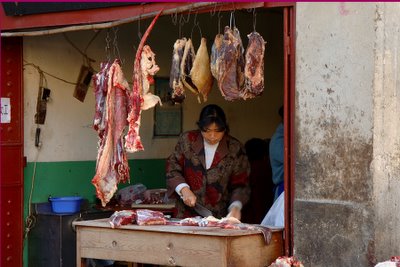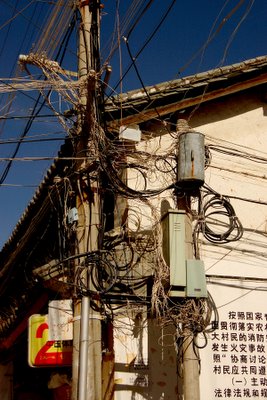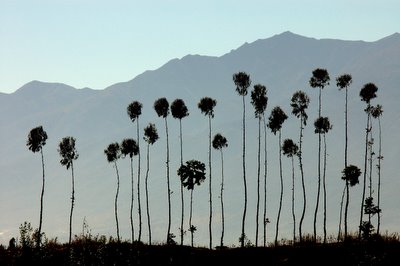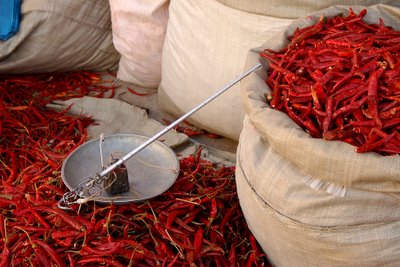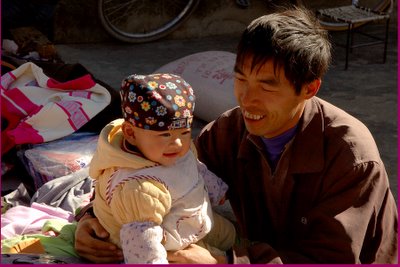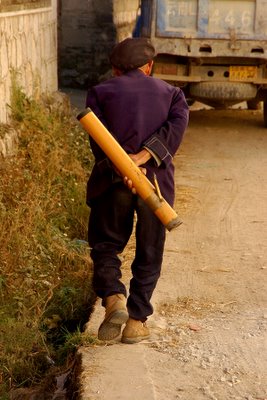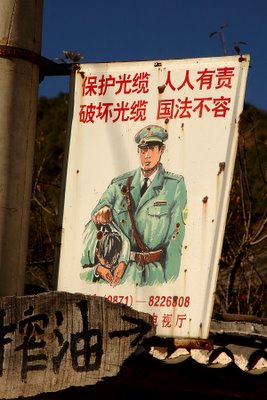
18 December 2005
On December 6 a group of villagers from a small town called Dongzhou in the Guangdong Province of southern China were protesting against what they felt was inadequate payment for land needed by the local government to build a coal-fired power plant. In the events that followed, Chinese security forces fired into the crowd, killing somewhere between 3 and 20 villagers depending on the source. As this story unfolded in the Chinese and foreign media, I followed it attentively, both because of my personal obsession with news and for the value of the events as provocative teaching material in my reading and writing classes here in China.
The coverage and the continuing developments have been interesting from the perspectives both of China’s control of in-country media and the West’s interpretation of events seen through the prism of our own notions of China.
I don’t know how many of you have followed this story. It was front page news in the New York Times and other Western papers (e.g., The Washington Post and The Times of London) soon after it occurred (links below), and follow-up stories have also appeared every day or two since. The China Daily published a small official government release on Sunday, December 11 (text included below).
New York Times, December 9: Police Fire on Protesters in China, Killing Several
New York Times, December 10: Villagers Tell of Lethal Attack by Chinese Forces on Protesters
The Times (of London), December 11: ’20 Shot Dead’ in Chinese Land Fight
China Daily (Xinhua), December 11: China reveals report on violence in South (see full text below)
The New York Times, December 12: China Detains Commander in Killing of Protesters
The New York Times, December 14: Beijing Casts Net of Silence Over Protest
Washington Post, December 15: China Waivers on Police Shooting
The New York Times, December 17: Chinese Pressing to Keep Village Silent After Clash
Protests in the news are the tip of the iceberg here (I believe) and most happen well out of the spotlight. According to some of the articles above, China experienced 74,000 significant protests in 2004, most of which did not involve violence and most of which were not reported in the press. The reasons for these protests are many, but the underlying tensions are tied to the growing imbalance between Chinese rich and poor and widespread corruption in a system that offers little opportunity for recourse, especially for the rural poor. A few courageous Chinese lawyers and others work hard to change this (also reported in the NYT recently).
The Chinese government is well aware of these problems and their potential for introducing political and social instability in this huge and diverse country where the poor are a majority. Consequently, shootings by police, like the ones that just occurred, are simultaneously taken seriously by the government and, to the extent possible in the information age, kept quiet. The strategy seems successful in the short term (my students knew nothing of this recent episode) but it can be argued that the discontent and awareness of it by some Chinese are forcing long term changes to the current system. For example, in response to the Dongzhou incident, a group of dissidents and intellectuals here and abroad have signed an open letter calling for the government to conduct an independent inquiry into the shootings and they have posted this letter on the internet, though it is currently blocked in China (to the best of my knowledge).
I was curious to discover what my students might think of the news and I put together a lesson plan with the intent of offering conflicting reports in a somewhat neutral way as a means both to examine bias in journalism and to motivate the students to do some reading and then English writing in unsigned opinion pieces. The results were interesting and sometimes unexpected.
My students are men and women of college age (18 – 21) from all over China, and though they are not top tier, most of them can speak and read English well enough to communicate. All of the students have access to the internet here on campus though almost none have computers of their own. Most are internet savvy, and many do have computers in their family homes that they did not bring with them to Yunnan. Also relevant is the fact that the internet, while partly restricted here, is more open than you might imagine (though I can’t access this blog!). Using the high speed access from my apartment on campus, I can read all of the newspapers that I’ve listed above including the full texts of their reports on China and other places, even when these reports contradict official accounts. The students have the same access.
I introduced the lesson and asked the students in three of my classes (about 120 students) if they had heard of the Dongzhou shootings. To my surprise, none of them had heard of it though nearly a week had passed. I dove in, presenting to them both the Xinhua (government controlled) account (full text included below), the New York Times account from December 10 and the Times of London account from December 11 . I read the former two to my writing classes and handed out all three to my reading class for them to read and discuss. Afterwards, I led a discussion about journalistic bias in which I suggested that both the Xinhua account and the December 10 New York Times account showed bias or at least slanted the story, albeit in opposite directions. Read the articles if you are interested and draw your own conclusions about objectivity and truth.
Below is the official account of the incident published in the China Daily on December 11. My apologies for not just posting the link, but I have been unable to find the article on the web since it was removed from the current China Daily website (it may still be available but I can’t find it).
China reveals report on violence in South
Xinhua (China) Updated: 2005-12-11 09:15
SHANWEI, Guangdong, December 10 (Xinhua) -- Hundreds of villagers incited by a few instigators violently attacked a wind power plant on December 6, and assaulted the police, the Information Office of the city government of Shanwei in south China's Guangdong Province said Saturday.
In an investigation report of the incident, the office called the armed assault a serious violation of law. According to the official recount, the instigators led by Huang Xijun engineered and organized some villagers in Dongzhoukeng and Shigongzhai to illegally besiege and attack a local wind power plant at noon on December 5 and December 6.
The first assault on December 5 caused a seven-hour suspension of the plant's power generation. In the second onslaught, over 170 armed villagers led by instigators Huang Xijun, Lin Hanru and Huang Xirang used in the attack knives, steel spears, sticks, dynamite powder, bottles filled with petroleum, and fishing detonators.
Police moving in to maintain order were forced to throw tear shells to break up the armed besiege, and arrested two insurgents. However, Huang Xijun mobilized over 300 armed villagers to form a blockade on the road to Shigongzhai Village to obstruct the return passage of the police, in attempt to threaten the police to release the arrested insurgents.
For a moment, many besiegers intended to quit following the persuasion shouted by the police. However, they were forced to stay in protest under the threat reinforced by the instigators, according to the report. Instigator Lin Hanru shouted through a loudspeaker that they would throw detonators to the police and blow the wind power plant, if the police refused to retreat.
It became dark when the chaotic mob began to throw explosives at the police. Police were forced to open fire in alarm. In the chaos, three villagers died, eight were injured with three of them fatally injured. Concerned government departments are still investigating in the exact cause of the death.
The Information Office said that the instigators with Huang Xijun at the core had incited villagers to join in armed protests since June, using villagers' discontents over a land requisition of a coal-fired power plant in Dongzhoukeng Village as the excuse.
They frequently formed armed protests in the construction ground of the coal-fired power plant, blocked public traffic, attacked government offices and even illegally detained people and vehicles passing through the village to threat the local government to approve more compensation fund in land requisition.
In order to magnify the effect of their protests, the instigators hatched the assault of the wind power plant in Shigongzhai Village, which had no relations with their former request for fund concerning the land requisition in Dongzhoukeng Village.
The provincial government of Guangdong pays great attention to the December 6 Incident. A special work group has been established to investigate in the incident, according to the Information Office.
First, recall that this is the Chinese government’s authorized version (Xinhua is the official news agency) of what happened. The first line sets the tone:
Hundreds of villagers incited by a few instigators violently attacked a wind power plant on December 6, and assaulted the police, the Information Office of the city government of Shanwei in south China's Guangdong Province said Saturday.
Clearly, the aggression of the villagers towards the police is the focus of Xinhua, and the police do what they can to keep the situation under control in the face of this misguided aggression. Only well into the account do we learn that:
It became dark when the chaotic mob began to throw explosives at the police. Police were forced to open fire in alarm. In the chaos, three villagers died, eight were injured with three of them fatally injured. Concerned government departments are still investigating in the exact cause of the death.
The New York Times, after publishing a balanced account of the incident by Joseph Kahn on December 9, presents the previously untold perspective of the villagers in the article from December 10 by Howard W. French. The NYT story begins:
Four days after a lethal assault on protesters by paramilitary forces, a village in southern China remained under heavy police lockdown on Saturday.
In this account, the protesters were assaulted by the paramilitary forests, rather than vice versa as described in the Xinhua account. The article details stories about the events, told by the villagers who relate first and second hand descriptions, many horrifying, of killing and brutality inflicted by the security forces. This article provides a few excerpts from the Xinhua account, but concentrates on the villagers depiction. Both accounts (Xinhua and NYT) were clearly slanted (though certainly the villagers stories needed to be told by a free press).
I asked my students if they thought the stories were biased and most said that yes, they clearly were. Surprisingly though (to me), many (though certainly not all) felt that the Xinhua (China Daily) story was more biased than the NYT account. In fact, students suggested that this was typical and that they were rarely able to get the real story in China.
I include below some anonymous student comments on the articles to provide insight into their sentiments. Of the 66 students who wrote for me, most felt that both Xinhua and the NYT were biased and most also felt that the police actions were unjustified in this situation. But not all students felt this way as you’ll see.
Interpretation of the student’s opinions wasn’t clearcut, but about 35 felt that the police shootings were not justified in Dongzhou, 11 felt that they were, and the rest were neutral or uncertain given the lack of clear information about the circumstances.
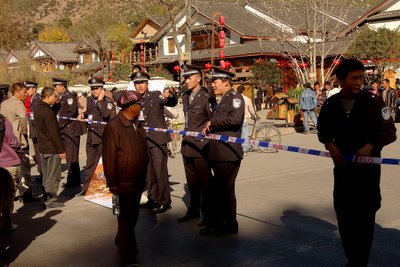
The following student’s opinion and the one after, it should be noted, are the only two among all responses that take a strong anti-villager stance and so are the tiny minority, but they are disturbing to say the least. I’m including them first so that the majority represented by the rest of the students are given the last word. Again, these first two are not representative, but they are two students of 66 (3% in this unscientific survey).
This first one is carefully hand-written on a piece of notebook paper that includes a watermark showing an overly cute little girl holding a baby chick:
In my opinion, the truth was just like what China Daily says. For I am Chinese. I know deeply that many of the villagers are not educated and more important is most of the uneducated villagers are very brutal. Sometimes they would do which is against the law. Once I saw on TV a local programme reported that many brutal villagers killed two reporters just because the two reporters wanted to report that they had done which were against the law. So through this case, it makes it clear. Most of the village in China are not civilization enough. If the police didn’t shooted out them it could be believed that the police might in dangerous or even be killed. Always for the land payments I can tell you that most of the case like this happened in Guangdong Province. The government will give the villagers equitable payments. Sometimes more than the land can be made for the lifetime of its owners. If we want to develop maybe sometimes we have to use force though it isn’t a good way to solve things like that. But things can get better, more modernization and more civilization.
And this one is similar:
After I read this news from two areas [newspapers] = Xinhua and New York Times. In my opinion, it’s good for police to shoot protesters. Because I had read the same news in Hebei Province in June this year. It cause of the land payments. The government wanted farmers to sell their freedom land to country, but farmers didn’t want to sell and rise the land price. So some of police talked to the farmer and wanted them to sell the land. Then some protesters had bad action, the police shot them. You know, in China, most of the farmers have no culture and always barbarism. They don’t know how to live rich and good. They don’t know what is better for the country. They are selfish! The province of them is so bad, they wanted to break a chaos.
The rest of the students that I’ll quote here generally have more balanced views or at least are more reasoned as they speak to many of the issues that play a role in Chinese politics.
This student addresses the corruption problem:
In this case, there must be enough money for this land. Now, why do the villagers say the price is too low? Only because there are some official governor of the local government make some money as their own. The “eat” part of the land payments! So the final price is lower than the bargaining. The villagers don’t know this for fact maybe, so they want to ask the local government to give them a suitable price. The local government certainly don’t want to “throw up” the money they had “ate.” So a fight broke out! I don’t know how to explain this clearly, but some official, some local governments really very disappoint. I think this fight case must has some relationship with the local government!
After our class discussions on news bias, many students tackled it in the context of this event.
This person’s response addresses censorship in China:
I hate China has covered up this event. I think China government has more responsibility to solve this event. It can not ask for a help from media. Every person concerned tried to cover up the truth. The truth need the law to expose. I don’t want the media of all of the world say some bias. I want China government bring the truth to light quickly. I think this case is China’s humiliation. China government is not only didn’t report this event, it also didn’t take strict way to solve this event. Could it be said that China government don’t take care about the people but only the economy?
As does this:
Every Chinese people know that Chinese government is always controlling the media, so we have reason to doubt the news from China Daily. But we don’t totally believe in the New York Times. From the NYT we can know more about this event and the truth. Police should not use deadly force except that when they are in danger of death. Police don’t have the right to use deadly force whenever they like. This event show the defective of the government. Some government leader corrupt and don’t do things to serve the people. I support the Chinese people to do things like the Guangdong peoples do. That will promote the government to solve the exist problems.
Many students wrote about differences between the NYT account and Xinhua:
The event is small but it has relate some political effect. Both China and the United States have reports about this. Each of them must support their points. The villager protect their plants [crops] and this they must live that depend on the plants. If you deprive their foodstuff everyone would know the result and government give them so little money. So I think the event is necessary. Another aspect, this event was reported on New York Times and same date are different from Chinese. That worth thinking for us. Nobody knows the truth. Why did the NYT say 20 people died and it is so much more than Xinhua report. It is obvious bias. Several years ago many events were happened such as BeiYue. WangWei died in NanHai...from these events we can realize that Americans and China are not very friendly in fact. And maybe there are many American think so. We can avoid the fact that some American has some biased opinion about China deeply! That’s terrible between American and China.
This student also speculates about the NYT story and expresses the student’s view that the U.S. government must influence U.S. news reporting:
I think the NYT is very famous in the United States. It also shows some opinion of some high politician. We can’t distinguish between China Daily and NYT. I think every country has their own position, every country has their own benefit. So we can’t compare China Daily with NYT. Maybe neither of us know its truth, after all we can’t know the detail except police and villagers.
From another student:
For this violent event, I think both the China Daily and the NYT are bias. China Daily represent the government’s right, and it supports the police more. Overseas’ newspapers may be bias to the Chinese government, and they support the villagers. But it is sure that they can’t compare this event with Tiananmen event in 1989. They are not the same thing. And in my opinion, the most probable reason is that the local government don’t benefit the local people. They expanded land to build factory and didn’t give enough money to the farmers. They can’t live with so little money. So they are angry and protest.
This student also speaks to bias and also to the events:
I think that the police should not use deadly force the villagers. According to the law, the Chinese people have equal rights. Everyone has not rights to kill others. China is a legal system country. It should use the law to run the people but it’s not too be run by someone. In the fact of Dongzhou the policies absolutely encroach on the village’s rights. It’s bad. China Daily record this fact. Maybe it is a little bias for the government or police but it tells us that a fact. NYT record about this fact. I think that it has a bias serious. Maybe it has exaggerated about this fact. For the newspaper, first of all, they must tell people the things is truth or it is a fact. Chinese government be built no long now. It has many problems.
This student was more offended by the NYT account:
The countries fight each other in the world just like the chicken fight for the food. I hate what the NYT said. It is obviously a action to attack the Chinese government. To be frank, the police should not kill people in this case. The land is owned by the villagers and they have the right to own or sold them. Maybe the villagers showed an unreasonable way to them, but the police should follow the law to respect the life right. The police have the right to kill a person only when he against our country’s law and harm our country’s benefits and safety. Otherwise it is a behavior of tort. I think neither the police nor the villagers would tell the truth, but it is true that the police kill the villagers. This must bring some bad effects to China, not only bring fear to Chinese but also be fighted by the world political. This will supply a chance for other countries.
Most student addressed the question of use of deadly force by police.
This explanation was well-balanced:
It’s not only a sad story but a serious problem that we should concern. The complicated event made me confused. Like everyone here, I want to know the truth. Both the Chinese newspaper and American newspaper are bias.
For my part first of all villagers should be paid enough for the land using. The investigators should invest if it was true that the payment was too low. Then if the villagers were violent and attacked police. In any case, police shouldn’t shoot someone. It was a conflict that should be solved in another way. Maybe the villagers were too angry and did this illegally. Frankly, I don’t know. I don’t want to add my feelings to this event. We should be objective. In China, there are too many people, too many villagers. Chinese government should look into such a case seriously and give everyone of all the world a truth. We must fact it because there are actually problems in villages.
In overseas countries, many of them showed different viewpoints. But for China, the government’s obligation is to invest the case and develop awareness of solving village problems.
Different countries have different situation. In China, it’s special and it will develop a high awareness of protecting and gaining rights. Laws are important, so the case taught a lesson for us. Everybody, both villagers and police are equal. They should obey the laws. Anyone who break it will be punished. Of course, the laws must be suitable and reasonable for the country.
And though most students could see both sides of the story many came down on one side or the other:
I don’t think the police should use deadly force because the villagers didn’t break law which can cause their dead and the police don’t have rights to kill them. Maybe the government gave a little money to the villagers but villagers shouldn’t threat police. I think they should have a communication with the government on peace not violence. American shouldn’t interfere this case, they should keep in the middle situation. Because they didn’t have rights to bias the Chinese government or villagers and maybe the news they heard was not fact, it was hearsay.
Another student:
The villagers were forced to threaten the police. They were the owners of the land. The have the right to decide how to use the land. Government had no right to interfere. I think the government should responsed [responsible?] for this matter. I know the villagers didn’t take legal measure to solve this matter. The government forced them to choose an illegal way. The police opened fire to the villagers. This behavior just like bandit. They killed several villagers and didn’t public the specific numbers. The police can use deadly force towards terrorists but not villagers! It’s very silly action. I think the government leaders of Dongzhou are stupid, silly donkeys. They ignore other people’s rights and benefits.
This last account suggests that things like this are blips on the road to a better China and urges that people should turn the other cheek and let the country evolve:
Yes, of course the police could use deadly force. Because police are also human. They also need human rights. If there is a difference, it must be that the police and the villagers have different jobs and responsibility. But police couldn’t use deadly force whenever they want. In China’s law, there is one note say ‘One people could kill another people just a the point that the people wants to kill him or hurt him badly.’ But I don’t know what really happen in the village. I was shocked when I heard the news. And I am not willing to say anything according to just two accounts on newspapers. Honestly, this is not the first time in China that this kind of thing happens. But it is a big news and maybe has a nationwide sensation. But you know Chinese government, sometimes, I want to say, it is really a little autocracy. Something that will be bad effect will be covered and dealt with stealthily. I just wondered, if some terrorists or some bad person spread the news and exaggerate it China is in danger. It is so frightening to think about the results. So most of time Chinese government is good, but sometimes it is brutal. It may because China is just developing and isn’t perfect. Let’s forget this thing just like we forgive a naughty boy who did something wrong. Don’t put too much pressure on China, he will grow up and he will be strong and calm to deal with all kinds of things. It just needs time to see the promising future.
The news articles and the students speak for themselves, and all of us can interpret the situation without further commentary. It should be said though, that the students here may not be typical. All of the foreign teachers here are painfully aware of a lack of worldliness and even strong curiosity among many of these students which may not reflect the attitudes of the young in more top-tier, urban universities in China. Remember that Yunnan is considered a frontier province and that this college is not at the top of the academic hierarchy in China. But, the students are from all over the country, including many big cities, and their views may reflect those of many Chinese.
Finally, a NYT article from December 17 describes an escalating cover-up and continuing brutality by authorities in Dongzhou. The story is still developing and I suspect the students here are not following it.
